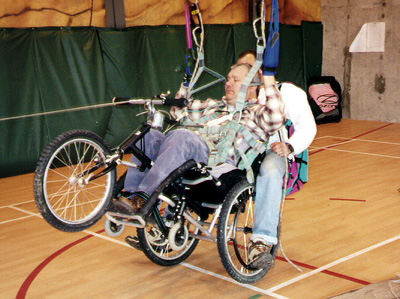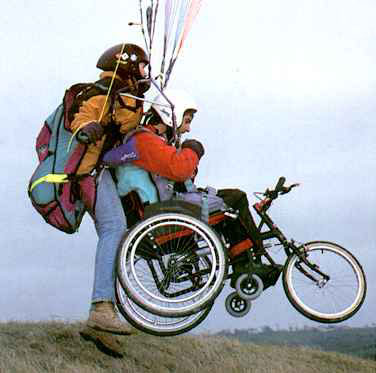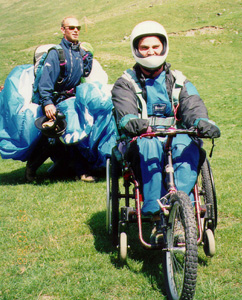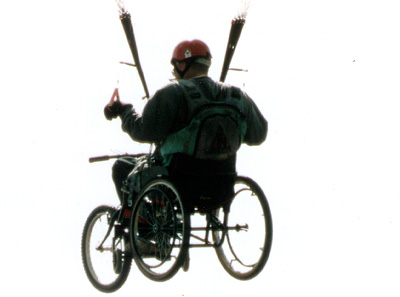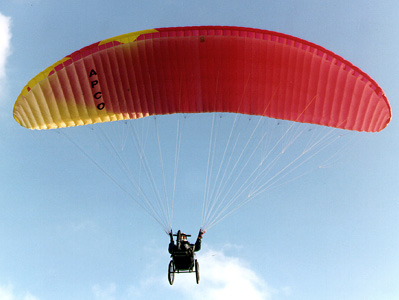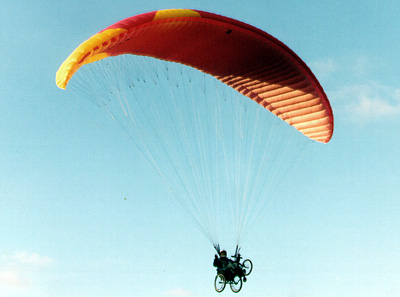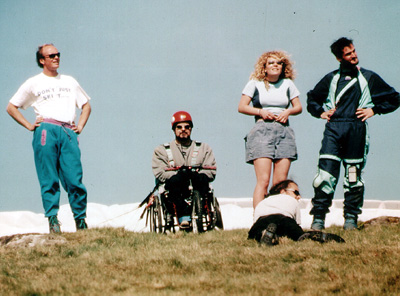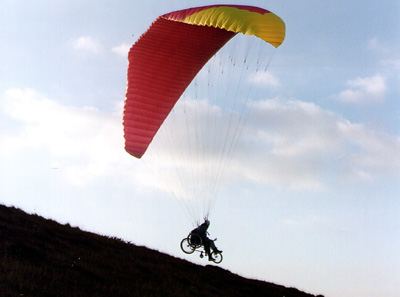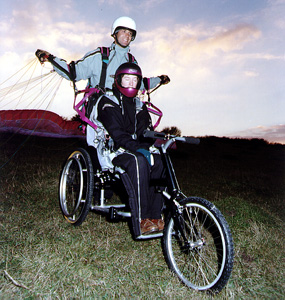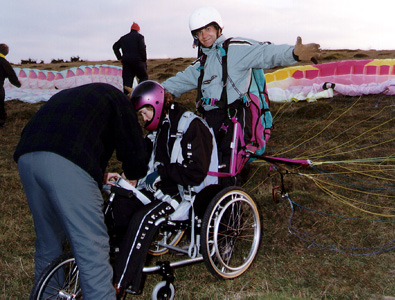In 1997 Flyability completed the development, design and testing of a wheelchair that will enable people with severe motor disabilities to fly paragliders. The purpose built (light alloy) paragliding wheelchair is suitable for both dual and solo flying, thus creating the opportunity for wheelchair users to train as pilots. The chair is unique in that it can be used as an everyday wheelchair, yet with the modular addition of a front wheel and a paragliding harness, the chair becomes flyable.
People with severe motor disabilities have been flying as passengers in tandem paragliders since 1992, when Jocky Sanderson developed the first dual paragliding ‘buggy’ in conjunction with the Calvert Trust (an outdoor activities centre in the Lake District for people with disabilities). Since then a large number of visitors to the Calvert Trust have been introduced to the sport. However, the limitations of the original buggy have always been apparent in that it could not be used for solo flight.
In 1996, John Crosbie (the Centre Director of the Calvert Trust and a Trustee of Flyability) was visiting the Chevron wheelchair factory to discuss a joint project with Chevron concerning ‘off road wheelchairs’. During the visit he saw the prototype of a new wheelchair designed by Vinny Ross, one of the Chevron engineering team and himself a wheelchair user. This chair has a suspension system built into the rear axle which minimises the risk of injury to off-road users. John immediately realised that, by combining the front end of the ‘off road’ chair with the rear suspension system, it would be possible to create a much improved flying undercarriage with solo potential.
The Flyability Trustees immediately approved an R&D budget for the project. John brought together the engineering knowledge and disability experience of Vinny Ross, the flying experience of Jocky Sanderson and his own knowledge of working with a wide range of disabilities in outdoor activities, and the adaptive experience of the Calvert Trust.
The resultant prototype has exceeded all expectations and offers a number of major benefits. First and foremost there are no flight safety or insurance issues because it is designed to be used in conjunction with standard flying equipment. Additionally, the chair is easy to handle from the dual pilots’ point of view and works well for solo pilots. It is not only stable but the steering mechanism is self correcting to minimise the effects of drift on landing. Last but not least, the new modular chair will not leave pilots stranded in the landing field – they can now simply wheel away. Flyability strongly recommends that quick release maillons are always used when flying with the chair.
Already the development of the chair has increased the interest of people with disabilities in taking up flying as a serious sport rather than a once only experience. The Calvert Trust, in conjunction with Jocky Sanderson’s Escape flying school in Keswick has run student pilot course for wheelchair users (one of whom was Vinny Ross).
Using the new chair, any paragliding school with suitably qualified instructors can now teach wheelchair users to fly under the standard BHPA rating scheme. The training sequence begins with tandem flying, giving the student the opportunity to learn the feel of the air and the charateristics of the canopy. Then, as canopy control improves, the student is able to move onto solo flying and progressing through the tasks laid down in the BHPA qualification schemes.
Jocky Sanderson
